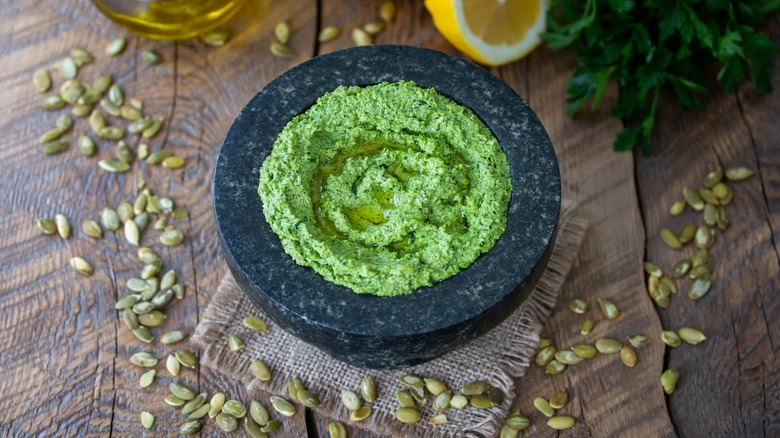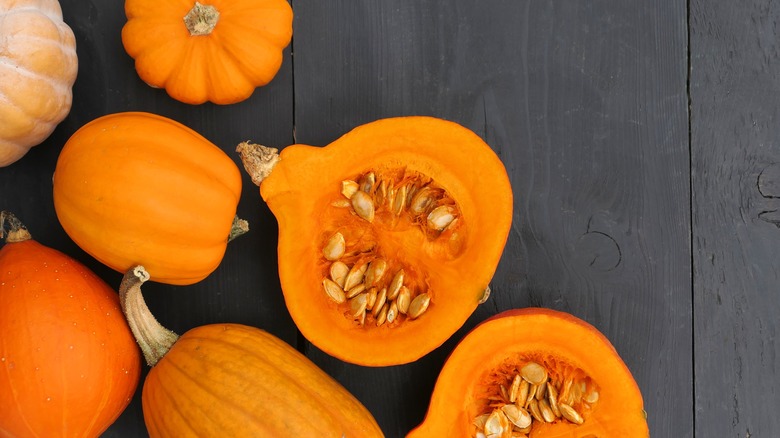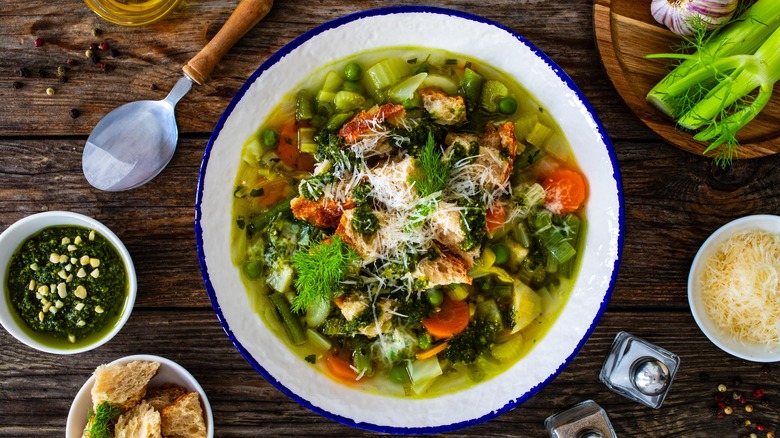Allergic To Nuts? Try This Ingredient Swap For A Nut-Free Pesto
With autumn upon us, we're entering high season for pumpkins — both because this is the time of year when they're harvested, and this is the time of year when kids remove their tops, pull out their guts, and carve spooky faces into them. The parents supervising this project often get left with a mess to clean up — and a lot of pumpkin seeds to figure out what to do with. Roasting them with salt is a fall-back option, but pumpkin seeds are a healthy ingredient with a ton of versatility in the kitchen, including in places where other nuts and seeds might be — like pesto.
Speaking of versatile: This bright-green Italian sauce is universally beloved and, as an ingredient, a flavor multiplier in everything from sandwiches to vinaigrettes to noodle dishes (if you've got pesto and cottage cheese, for instance, you have all the ingredients you need for a creamy, easy pasta sauce for that perfect late-summer pasta). Still, the fact that it contains pine nuts — in addition to basil, olive oil, and Parmesan cheese — can pose a problem for folks with nut allergies. If you're looking for a pine nut alternative, in short, here's a place where pumpkin seeds will shine.
The benefits of pumpkin seeds — and how to use them in pesto
Even folks who don't otherwise react to tree nuts can have trouble with pine nuts: See the dreaded "pine mouth," which causes an unpleasant metallic taste to develop in sufferers' mouths that can last for weeks. Pumpkin seeds (aka pepitas) don't pose this problem, and like other seeds, such as sesame and poppy, they often don't provoke a reaction in folks with tree nut allergies. As far as pesto is concerned, pumpkin seeds have another big advantage: Pine nuts are very expensive. Pumpkin seeds are not. They're also great for you — a source of magnesium, which helps keep blood pressure low, pumpkin seeds are high in fiber, omega-3 fatty acids, and the kinds of antioxidants that contribute to reduced cancer risk and better heart health.
But enough about cost and health — we're here to talk pesto. If you want to swap pumpkin seeds in for pine nuts in your pesto, that's all you do: a one-to-one swap. If you're starting with raw seeds, you can bring out their flavor by toasting them in a medium oven — or in a carefully watched pan on the stovetop — just until they're slightly brown and a little fragrant. If you buy pumpkin seeds that are already roasted, skip this step. It'd also be fine to use roasted and salted pumpkin seeds here, but just hold back on whatever salt the recipe calls for and add later as needed, tasting as you go.
Another option for nut-free pesto
If you have an allergy that extends to pumpkin seeds, though, or even just a dislike of them, it's not fair for you to be deprived of the wonders of pesto altogether — and you don't need to be. The simple solution is to just not add them. You don't need to call this variation "nut-free pesto" or anything like that; you can call it, instead, pistou.
If pesto is a classic of Italian cuisine, probably originating in the Ligurian capital of Genoa, you can think of pistou as its stripped-down cousin from just down the Mediterranean coast. Associated with the South of France, pistou typically omits pine nuts and sometimes even cheese: At its simplest, it's a purée of basil, olive oil, garlic, and salt. Traditionalists would have you smash this all up with a mortar and pestle, though those with less patience and upper-arm strength might say that a blender or a food processor is fine. Some also add cheese and tomatoes.
Ready to swap in anywhere you might otherwise use pesto, pistou is also the star player in the Provencal answer to Italian minestrone: soupe au pistou, a hearty, warming — and nut-free — vegetable soup enlivened by that garlicky, herby sauce. Perfect, in other words, for the cool nights ahead.


